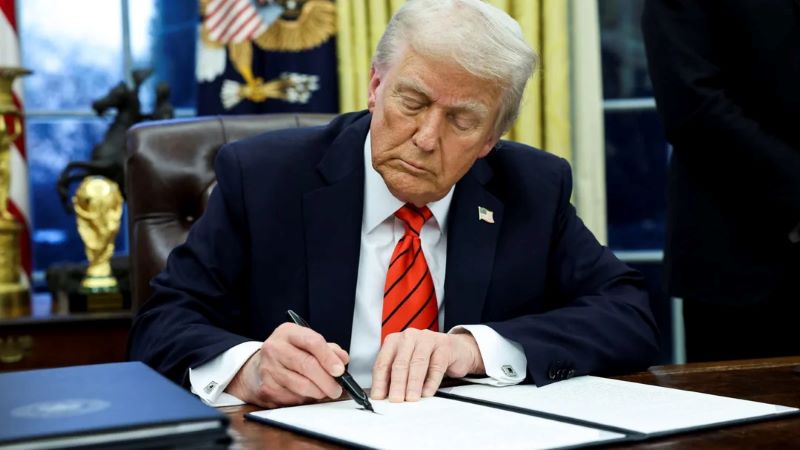President Trump, who has repeatedly promoted the idea of ‘small government, big freedom’ by reducing federal government intervention during his presidency, has recently taken his controversial proposal to close the U.S. Department of Education a step further. This proposal has sparked a wide-ranging debate about not only the direction of the education system but also the major restructuring of the functioning of the U.S. government.
Trump’s Education Policy Philosophy
Trump’s philosophy of education reform can be traced back to one of the promises he made during his campaign: to reduce federal government intervention and increase local government and family control in education. Trump argues that excessive federal intervention through the Department of Education has led to inefficient allocation of educational resources and uneven quality of education. He emphasized that local governments and private schools should have more say and decision-making power in education and that the federal government should not intervene excessively, especially in areas such as textbook content and school management.
During his tenure, the Trump administration has pushed through several education policy reforms, including the education voucher system, which allows families to use government-provided funds to attend private schools, a measure intended to improve the quality of education through market-based competition. Trump has simultaneously reduced the Department of Education’s budget and proposed streamlining some federally related education policies. Through these initiatives, Trump has attempted to lessen the disruption of federal education policy on localities and families.
Role and Rethinking
Since its creation in 1965, the U.S. Department of Education has assumed many key functions, including providing financial aid to students from low-income families, overseeing the nation’s education system, and maintaining educational equity. However, the Trump administration has argued that the over-centralization of these functions at the federal level has led to the inefficient implementation of education policy and neglected the diversity of local needs. In particular, Trump cites that federal intervention in education has made educational standards too uniform to meet the needs of different states and regions.
Additionally, the Trump administration argues that the existence of the Department of Education has also resulted in significant financial expenditures and an unsatisfactory role in the public education system. The Education Department’s large budget and bureaucracy are cited as one of the reasons for the slow process of education reform and innovation. Trump’s position is that many educational matters should be decided by local governments, private educational institutions, and families, rather than by the federal government.
According to the latest news, Trump signed an order to close the Department of Education in an attempt to reduce federal government intervention in education and delegate more authority to local governments and private educational institutions.
Challenges
While Trump’s signing of the proposal to close the Department of Education is in line with his philosophy of reducing the functions of the federal government, the implementation of this decision may have a series of far-reaching consequences, especially in terms of the distribution of educational resources and educational equity.
- Imbalance in educational resources
The Department of Education (DOE) plays a crucial role in the U.S. education system, especially in providing educational resources and financial support for low-income families, special education, and minority students. If the Department of Education is closed, there may be gaps in federal funding support for education, especially in districts that need special funding support. The lack of regulation and support at the federal level may lead to inequities in resource allocation by some state and local governments, making the quality of education in poor and remote areas even lower. - Erosion of educational equity
The Ministry of Education is also responsible for overseeing racial and gender equity in schools and ensuring that all students have equal access to education. If the Department of Education is shut down, the federal government’s role in ensuring educational equity may be weakened, and local governments may neglect the rights of students from minority and low-income families, leading to further centralization and inequality of educational resources. - Imbalance in education policy
While Trump’s proposed closure of the Department of Education may reduce administrative expenses in the short term, the closure of such an important department could lead to an imbalance in U.S. education policy in the long term. The Department of Education is not only responsible for setting education standards across the United States but also plays an important role in coordinating and integrating education policy across states. Losing the unified coordination of the Department of Education may lead to the fragmentation of education policies and increased differentiation among states and local governments in terms of education content and assessment standards, thus affecting the overall quality of education in the country. - Widening gap between private and public schools
The Trump administration has promoted private education and introduced an education voucher system, arguing that it can improve the quality of education and incentivize schools to improve teaching standards through competition. However, such policies may lead to a skewing of education resources in favor of wealthy families, further exacerbating the gap between private and public schools. As private schools are generally more expensive, low-income families may not be able to enjoy equal educational opportunities, and the problem of educational inequality will be further aggravated.
Realistic Difficulty
Despite Trump’s signing of a proposal to close the Department of Education, the reality is that the implementation of this proposal faces significant political and administrative challenges.
Legislative resistance
The Department of Education, a key function of the U.S. government, involves millions of students and teachers. Closing the department would require congressional approval and would be met with strong opposition from the education community, parents, students, and multi-partisan political forces. The closure of the Department of Education would not only affect the allocation of funds, but also involve changes in education policy nationwide, and a majority of members of Congress would likely not support the proposal, especially those from states and districts with a strong stake in education.
Administrative and legal challenges
The closure of the Department of Education is not a simple administrative decision. It requires the reallocation of all federal education functions and involves substantial legal and policy adjustments. At the same time, the Department of Education is responsible for a range of federal education loans, special education grants, and other programs, all of which will need to find alternatives in other departments or agencies. This massive administrative restructuring could lead to a decline in government efficiency and create unnecessary confusion.

Prospects and Challenges
Trump’s signing of the proposal to close the Department of Education faces significant challenges, both in terms of policy and practicality. Although the proposal reflects Trump’s political philosophy of promoting ‘smaller government’ and reducing federal intervention, resistance at the political, legislative, and administrative levels will make the proposal less viable if it is to be implemented.
Education is one of the core issues in American society, and closing the Department of Education could have serious consequences such as uneven distribution of educational resources and weakening of educational equity. Although Trump has proposed a policy of reducing government functions, there are still huge challenges to be faced to achieve this goal while balancing the quality and equity of education. Whether the United States can make substantial progress in education reform in the future will depend on the balance and wisdom of policy implementation.












